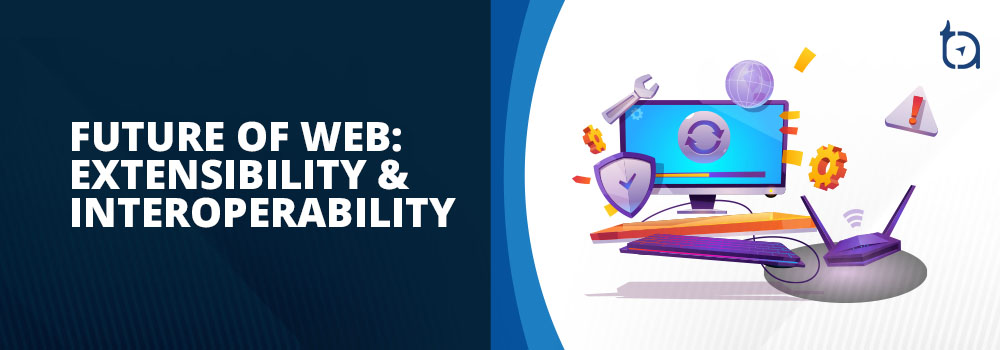Future of Web Technology: Interoperability & Extensibility

Author : John Prabhu 7th May 2020

In recent times, the web has gone through a significant amount of changes and is updated well enough. Starting with this new decade, we predict that the web will be directed towards interoperability and extensibility.
Let’s start by looking into interoperability.
1.Interoperability
With a technical approach, a lot of product companies are switching between technology stacks, implementing multiple stacks, or migrating from one stack to another. In some cases, they are trying to safeguard certain stacks as they might go out-dated due to future changes.
a. Web Components
From a web-standards perspective, web components might solve the problem of component-based architecture. Here, the idea is to devise a standard format that can be used either with a library or without. Thus, it enhances the development experience and ensures uniformity across components. Every web component is encapsulated and works perfectly fine across browsers without dependencies, and web components are going to witness a lot of growth in the coming years.
b. Logical Properties
Logical properties help us handle layout sizing for different languages and reading modes with a unique perspective. It makes the layouts to be interoperable with the user experience. For most of the left to right languages, we use a compass-type expression for margins, borders, & padding, and think of layouts as height and width. The scene totally changes when you have to deal with a right-to-left language. Because none of your padding-left is going to have any effect on your layout and it gets messy.
So, the solution is to write the styles as padding-inline-start and not padding-left to make your layout adjust to the changes correctly when switching from left-to-right to right-to-left.
c. Preference Media Queries
Preference media queries help you to customize your site to satisfy the needs of users who choose high contrast or dark mode and who choose less animation-heavy front-end experience. Below are some of the preference media queries for your reference:
- prefers-color-scheme
- prefers-contrast
- prefers-reduced-motion
- prefers-reduced-transparency
2.Extensibility
Extensibility is about stretching technology and extending it to satisfy the required project needs. By every passing year, we started designing and developing web with component-based (React component, Vue component, etc.) approach. The extensibility on the web gives us an opportunity to customize the platform to our requirements and play around with the outcomes.
a. CSS Houdini
Also, with CSS HoudiniCSS HoudiniHoudini is a group of APIs that give developers direct access to the CSS Object Model (CSSOM), enabling developers to write code the browser can parse as CSS, thereby creating new CSS features without waiting for them to be implemented natively in browsers., you can now easily extend CSS Object Models and instruct browsers on how to read and render CSSCSSCascading Style Sheets is a style sheet language used for describing the presentation of a document written in a markup language like HTML. CSS is a cornerstone technology of the World Wide Web, alongside HTML and JavaScript.. As a result, you can now include certain styles that weren’t available on the web earlier.
CSS Houdini is nothing but a set of different browser APIAPIAn application program interface (API) is a set of routines, protocols, and tools for building software applications. Basically, an API specifies how software components should interact. Additionally, APIs are used when programming graphical user interface (GUI) components. aimed at enhancing browser performance. The best part about Houdini is that it enables styling more extensible and allows you to dictate your own styles. Below are some of the Houdini APIs:
- Properties and Values
- Paint API
- Animation Worklet
- Typed Object Model
- Layout API
You can use these APIs to create semantic CSS and apply semantics to your CSS variables such as properties and values. Let’s take a quick look at the Paint API with which you draw a canvas and use it as a border-image. Also, with the help of a single line of CSS code, you can create animated sparkles.
Using the Layout API, you can start designing round menus and you don’t have to place them manually. Also, using the Animation Worklet you can integrate custom interactions written by you.
b. Variable Fonts:
Another extensibility feature to make websites more functional is variable fonts. According to Can I Use, 87% of modern browsers support variable fonts. Recently, Google launched the beta version of Google Fonts in which variable fonts are made available and are easy to use in your web projects. Also, variable fonts are vector-based graphics and you can set different values for distinct axes such as weight, slant, etc. To tap your creative side of the brain, they allow you for new axes.
Final Thoughts
In 2020 and the coming years, it is for sure that the web interoperability and extensibility will make a significant difference in the way you approach front-end design (including layout sizing, variable fonts, etc.). With all these tips, you can give more control to your users over how they want to see and read content from your website or application.
We, at TechAffinity, have expert front-end developers who are on par with the contemporary industry standards. You can line up your further queries about front-end design to media@techaffinity.com or schedule a meeting with our experts.
